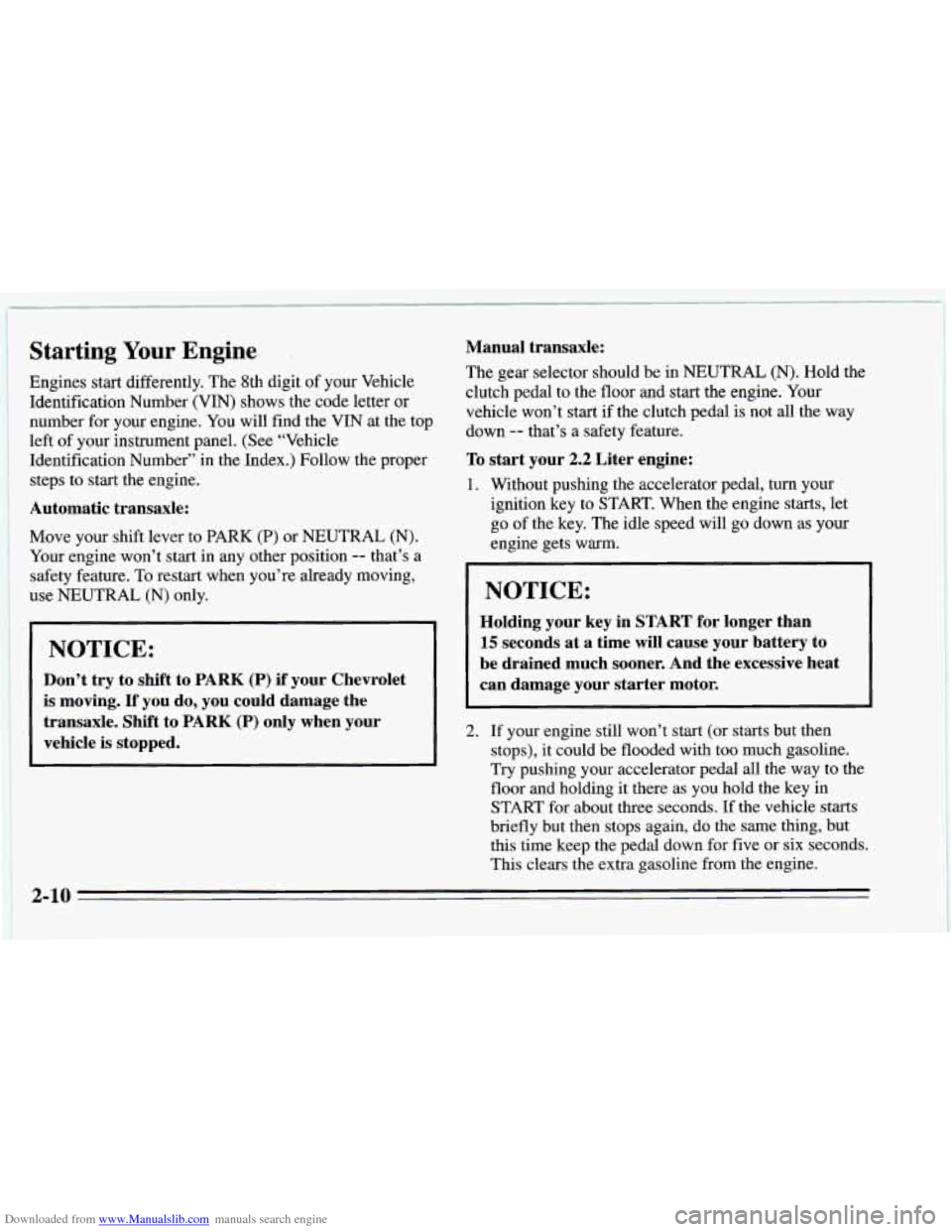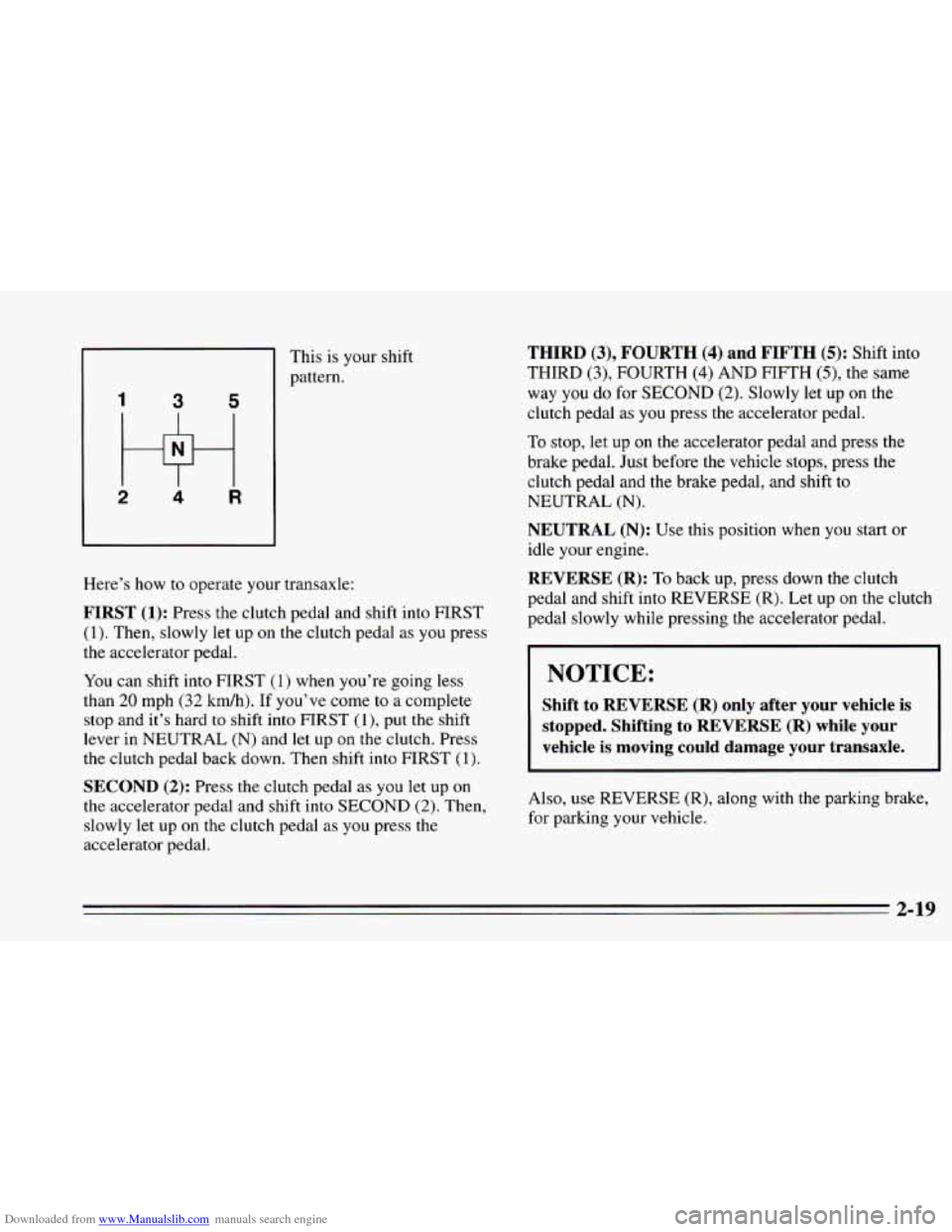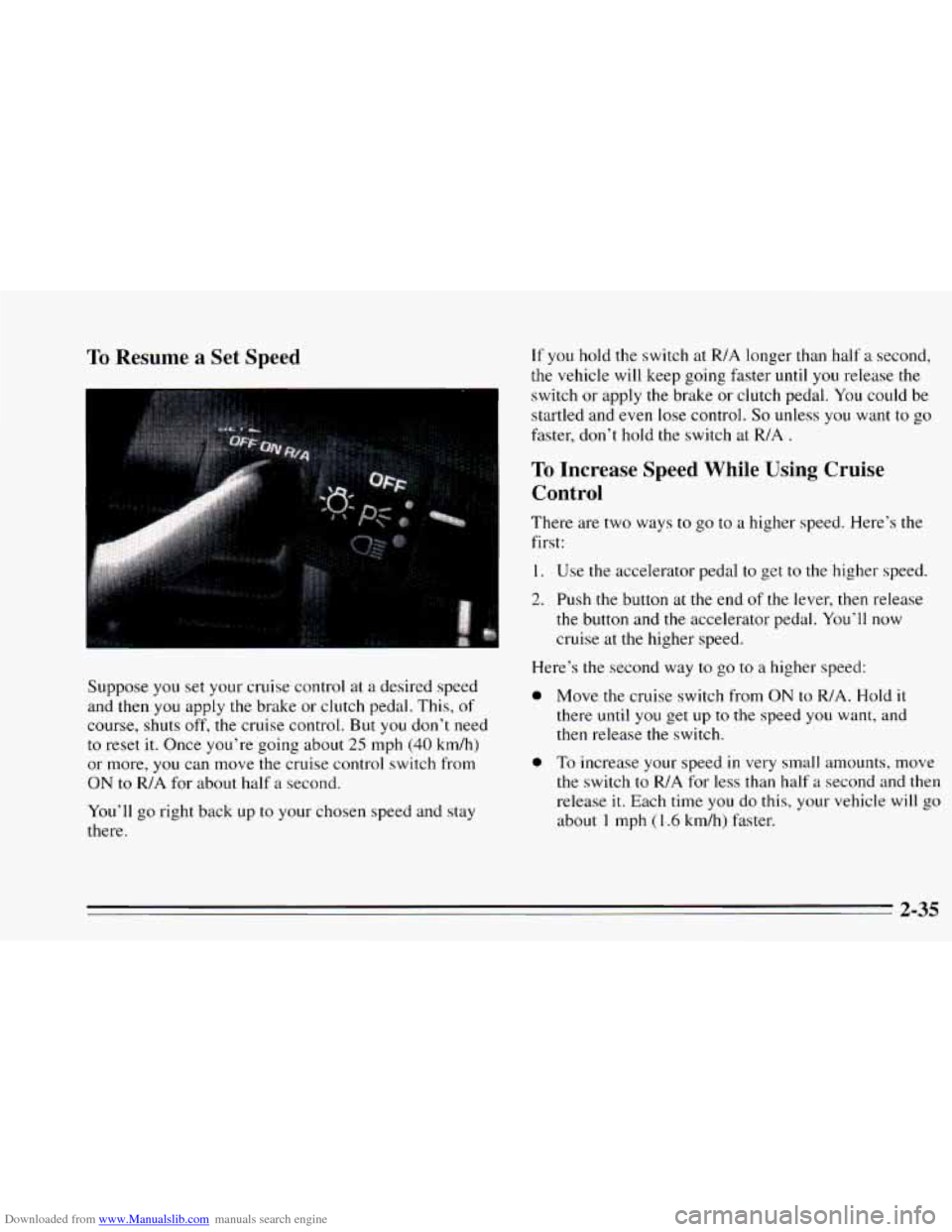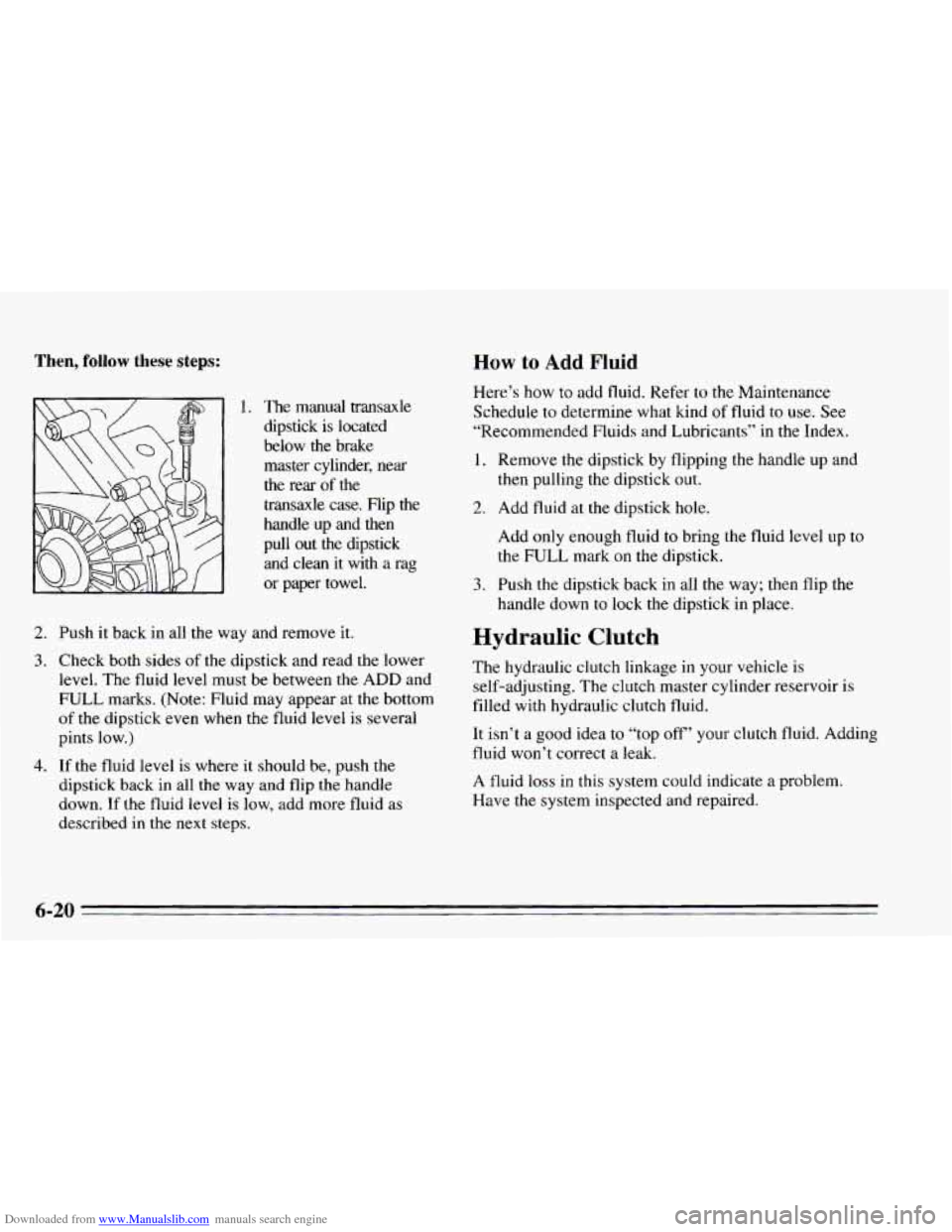Page 66 of 340

Downloaded from www.Manualslib.com manuals search engine Starting Your Engine.
Engines start differently. The 8th digit of your Vehicle
Identification Number (VIN) shows the code letter
or
number for your engine. You will find the VIN at the top
left
of your instrument panel. (See “Vehicle
Identification Number” in the Index.) Follow the proper
steps to start the engine.
Automatic transaxle:
Move your shift lever to PARK (P) or NEUTRAL (N).
Your engine won’t start in any other position -- that’s a
safety feature. To restart when you’re already moving,
use NEUTRAL
(N) only.
NOTICE:
Don’t try to shift to PARK (P) if your Chevrolet
is moving. If you do, you could damage the
transaxle. Shift to PARK
(P) only when your
vehicle
is stopped. Manual transaxle:
The gear
selector should be in NEUTRAL (N). Hold the
clutch pedal to the floor and start the engine. Your
vehicle won’t start
if the clutch pedal is not all the way
down
-- that’s a safety feature.
To start your 2.2 Liter engine:
1. Without pushing the accelerator pedal, turn your
ignition key to START. When the engine starts, let
go of the key. The idle speed will go down as your
engine gets warm.
NOTICE:
Holding your key in START for longer than
15 seconds at a time will cause your battery to
be drained much sooner. And the excessive heat
can damage your starter motor.
2. If your engine still won’t start (or starts but then
stops), it could be flooded with too much gasoline.
Try pushing your accelerator pedal all the way to the
floor and holding it there as you hold the key in
START for about three seconds. If the vehicle starts
briefly but then stops again, do the same thing, but
this time keep the pedal down for five or six seconds.
This clears the extra gasoline from the engine.
2-10
Page 75 of 340

Downloaded from www.Manualslib.com manuals search engine 1
1 3 5
2 4 R
This is your shift
pattern.
Here’s how
to operate your transaxle:
FIRST (1): Press the clutch pedal and shift into FIRST
(1). Then, slowly let up on the clutch pedal as you press
the accelerator pedal.
You can shift into FIRST
(1) when you’re going less
than
20 mph (32 km/h). If you’ve come to a complete
stop and it’s hard to shift into
FIRST (l), put the shift
lever in NEUTRAL (N) and let up on the clutch. Press
the clutch pedal back down. Then shift into FIRST
(1).
SECOND (2): Press the clutch pedal as you let up on
the accelerator pedal and shift into SECOND
(2). Then,
slowly let up on the clutch pedal as you press the
accelerator pedal.
THIRD (3), FOURTH (4) and FIFTH (5): Shift into
THIRD
(3), FOURTH (4) AND FIFTH (5)’ the same
way
you do for SECOND (2). Slowly let up on the
clutch pedal
as you press the accelerator pedal.
To stop, let up on the accelerator pedal and press the
brake pedal. Just before the vehicle stops, press the
clutch pedal and the brake pedal, and shift to
NEUTRAL (N).
NEUTRAL (N): Use this position when you start or
idle your engine.
REVERSE (R): To back up, press down the clutch
pedal and shift into REVERSE
(R). Let up on the clutch
pedal slowly while pressing the accelerator pedal.
I NOTICE:
Shift to REVERSE (R) onIy after your vehicle is
stopped. Shifting to REVERSE
(R) while your
vehicle is moving could damage your transaxle.
Also, use REVERSE (R), along with the parking brake,
for parking your vehicle.
2-19
Page 77 of 340
Downloaded from www.Manualslib.com manuals search engine Parking Brake
~~~
NOTICE:
If you skip more than one gear when you
downshift,
or if you race the engine when you
downshift, you can damage the clutch or
transaxle.
The parking brake lever is located between the bucket
seats.
2-21
Page 89 of 340
Downloaded from www.Manualslib.com manuals search engine Cruise Control (Option)
With cruise control, you can maintain a speed of about
25 mph (40 km/h) or more without keeping your foot
on the accelerator. This can really help on long trips.
Cruise control does
not work at speeds below about
25 mph (40 km/h).
When
you apply your brakes, or the clutch pedal, the
cruise control shuts
off.
2-33
Page 91 of 340

Downloaded from www.Manualslib.com manuals search engine To Resume a Set Speed
Suppose you set your cruise control at a desired speed
and then you apply the brake or clutch pedal. This, of
course, shuts off, the cruise control. But you don’t need
to reset
it. Once you’re going about 25 mph (40 kdh)
or more, you can move the cruise control switch from
ON to R/A for about half a second.
You’ll go right back
up to your chosen speed and stay
there.
If you hold the switch at R/A longer than half a second,
the vehicle will keep going faster until
you release the
switch or apply the brake or clutch pedal. You could be
startled and even lose control.
So unless you want to go
faster, don’t hold the switch at R/A .
To Increase Speed While Using Cruise
Control
There are two ways to go to a higher speed. Here’s the
first:
1. Use the accelerator pedal to get to the higher speed.
2. Push the button at the end of the lever, then release
the button and the accelerator pedal. You’ll now
cruise at the higher speed,
Here’s the second way to
go to a higher speed:
0
0
Move the cruise switch from ON to R/A. Hold it
there until you get up to the speed you want, and
then release the switch.
To increase your speed in very small amounts, move
the switch to
R/A for less than half a second and then
release
it. Each time you do this, your vehicle will go
about 1 mph (I .6 km/h) faster.
2-35
Page 92 of 340

Downloaded from www.Manualslib.com manuals search engine To Reduce Speed While Using Cruise
Control
There are two ways to reduce your speed while using
cruise control:
Push in the button at the end of the lever until you
reach the lower speed
you want, then release it.
To slow down in very small amounts, push the
button for less than half a second. Each time you do
this, you’ll
go about 1 mph (1.6 kmh) slower.
Passing Another Vehicle While Using Cruise Control
Use the accelerator pedal to increase your speed. When
you take your foot off the pedal, your vehicle will slow
down to
the cruise control speed you set earlier.
Using Cruise Control on Hills
How well your cruise control will work on hills depends
upon your speed, load, and
the steepness of the hills.
When going up steep hills,
you may have to step on the
accelerator pedal
to maintain your speed. When going
downhill, you may have to brake or shift to a lower gear
to keep your speed down. Of course, applying the brake
or clutch pedal takes
you out of cruise control. Many
drivers find this
to be too much trouble and don’t use
cruise control on steep hills.
To Get Out of Cruise Control
There are several ways to turn off the cruise control:
Step lightly on the brake pedal, or push the clutch
pedal, if you have
a manual transaxle; OR
Move the cruise switch to OFF.
To Erase Cruise Speed Memory
When you turn off the cruise control or the ignition,
your cruise control
set speed memory is erased.
2-36
Page 213 of 340
Downloaded from www.Manualslib.com manuals search engine 2.3L Engine (Code D) When you open the hood, you’ll see:
1.
2.
3.
4.
5.
6.
7.
8.
9.
Coolant Surge Tank
Power Steering Fluid Reservoir
Engine
Oil Dipstick
Brake Fluid Reservoir
Hydraulic Clutch Fluid Reservoir
(if equipped)
Battery
Windshield Washer Fluid Reservoir
Air Cleaner
Engine Oil Fill Cap
6-9
Page 224 of 340

Downloaded from www.Manualslib.com manuals search engine Then, follow these steps: How to Add Fluid
Here’s how to add fluid. Refer to the Maintenance
Schedule
to determine what kind of fluid to use. See
“Recommended Fluids and Lubricants” in the Index. ~ , 1. The manual transaxle
dipstick is located
below the brake
master cylinder, near the rear
of the
transaxle case. Flip the
handle up and then pull out the dipstick
and clean it with a rag
or paper towel.
2. Push it back in all the way and remove it.
3. Check both sides of the dipstick and read the lower
level. The fluid level must be between the
ADD and
FULL
marks. (Note: Fluid may appear at the bottom
of the dipstick even when the fluid level is several
pints
low.)
4. If the fluid level is where it should be, push the
dipstick back in all the way and flip the handle
down.
If the fluid level is low, add more fluid as
described
in the next steps.
1. Remove the dipstick by flipping the handle up and
then pulling the dipstick out.
2. Add fluid at the dipstick hole.
Add only enough fluid to bring the fluid level up to
the FULL mark on the dipstick.
3. Push the dipstick back in all the way; then flip the
handle down to lock the dipstick in place.
Hydraulic Clutch
The hydraulic clutch linkage in your vehicle is
self-adjusting. The clutch master cylinder reservoir
is
filled with hydraulic clutch fluid.
It isn’t
a good idea to “top off’ your clutch fluid. Adding
fluid won’t correct a leak.
A fluid loss in this system could indicate a problem.
Have the system inspected and repaired.
6-20